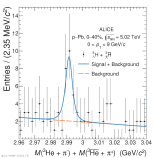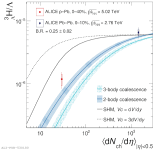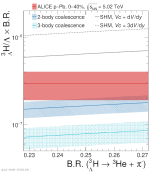Figures from paper submitted to Physical Review Letters
Abstract:
The study of nuclei and antinuclei production has proven to be a powerful tool to investigate the formation mechanism of loosely bound states in high-energy hadronic collisions. The first measurement of the production of ${\rm ^{3}_{\Lambda}\rm H}$ in p-Pb collisions at $\sqrt{s_{\rm{NN}}}$ = 5.02 TeV is presented in this Letter. Its production yield measured in the rapidity interval $-1 <~ y <~ 0$ for the 40% highest multiplicity p-Pb collisions is ${\rm d} N /{\rm d} y =[\mathrm{6.3 \pm 1.8 (stat.) \pm 1.2 (syst.) ] \times 10^{-7}}$. The measurement is compared with the expectations of statistical hadronisation and coalescence models, which describe the nucleosynthesis in hadronic collisions. These two models predict very different yields of the hypertriton in charged particle multiplicity environments relevant to small collision systems such as p-Pb and therefore the measurement of ${\rm d} N /{\rm d} y$ is crucial to distinguish between them. The precision of this measurement leads to the exclusion with a significance larger than 6.9$\sigma$ of some configurations of the statistical hadronization model, thus constraining the theory behind the production of loosely bound states at hadron colliders.
Phys. Rev. Lett. 128 (2022) 252003
e-Print: arXiv:2107.10627 | PDF | inSPIRE




